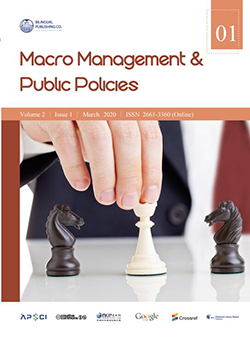-
932
-
350
-
274
-
258
-
241
Online Content Impact on Young people’s Values Transformation
DOI:
https://doi.org/10.30564/mmpp.v2i1.1048Abstract
The investigation that underpins the present article interprets the gaps of the social data continuum. It is designed to select a set of images from the “media noise” of the information society, and then describe those that characterize the visual conceptualization of the ideas. The authors present the results of their 14-year research based on the original research methodology, and carried out in several stages (2006, 2012, 2017). The study is called “Fictional creatures of the mass media era. Russia, 21 century”. In 2017, it is assumed that the overall youth international value agenda, an essential feature of which is the further reduction of the impact of advertising and brand communications, has been formed. Specific data are given in the article.
Keywords:
Online content; Social media; Youth values; E-values; E-society; Imaginary character; Internet; Mass media; Content analysis; Social-demographic analysis; Rough statistical analysis; Deep axiological analysisReferences
[1] Ulianovskii, A., Golubev, V., Filatova, O., Smirnov, A. Social Media Impact on the Transformation of Imaginary Political Characters in Russian Youth Culture. In Chugunov, A., Bolgov R., Kabanov, Y., Kampis, G.,Wimmer, M. (eds.) The Digital Transformations & Global Society. Conference paper, CCIS, Springer, 2016, 674: 35-44.
[2] Filatova, O., Golubev, V., Ulianovskii, A. Young people’s values: Identifying trends in Russian e-society. In EGOSE’ 16 Proceedings of the International Conference on Electron-ic Governance and Open Society: Challenges in Eurasia, pp.143-148. ACM International Conference Proceeding Series. NY, USA, 2017.
[3] Karyagin, M. Russian Large Cities Authorities’ Pages in Social Media: A Platform for Ex-pert Communication? In Chugunov, A., Bolgov R., Kabanov, Y., Kampis, G.,Wimmer, M. (eds.) The Digital Transformations & Global Society. Conference paper, CCIS, Springer, 2016, 674: 14-21.
[4] Rheingold, H. The Virtual Community: Homesteading on the Electronic Frontier. The MIT Press, Cambridge, 2000: 448.
[5] Katz, E., Lazarsfeld, P. F. Personal influence: The part played by people in the flow of mass communication. Glencoe, IL: Free Press, 1955.
[6] Cassirer, E. The Myth of the State. Greenwood Press, 1979.
[7] Bottici, C. Myths of Europe: A theoretical approach. Journal of Educational Media, Memory, and Society, 2007, 1(2): 9-33.
[8] Runduzzo, S. The Myth Makers. Probus Publishing, Cambridge, England, 1995.
[9] Mishankina, N., Zilberman, N. “Soviet” in the space of social networks: a form of political reflection. In Chugunov, A., Bolgov R., Kabanov, Y., Kampis, G.,Wimmer, M. (eds.) The Digital Transformations & Global Society. Conference paper, CCIS, Springer, 2016, 674: 45-50.
[10] Qualman, E. Socialnomics: How social media transform the way we live and do business. Wiley, 2009.
[11] Shcheblanova,V., Gagarin, Y., Bogomiagkova, E. and Semchenko, T. The Phenomenon of the Virtual Youth Twitter-community in the Discourses of Sociological Concepts and Self-Representations. In Chugunov, A., Bolgov R., Kabanov, Y., Kampis, G.,Wimmer, M. (eds.) The Digital Transformations & Global Society. Conference paper, CCIS, Springer, 2016, 674: 3-13.
[12] Fischer, C. Considering the “magical” world of consumption. In Berkeley Journal of Soci-ology, 2005, 49: 137-157.
[13] Ritzer, G. The “magical” world of consumption: Transforming nothing into something. In Berkeley Journal of Sociology, 2005, 49: 117-136.
[14] Studies in mundane reality. 1989. In Qualitative Sociology. N.Y. 1989, 12(4): 333-431.
[15] Karlan, D., Lazar, A., Salter, J. The 101 Most Influential People Who Never Lived: How Characters of Fiction, Myth, Legends, Television, and Movies Have Shaped Our Society, Changed Our Behavior, and Set the Course of History. Harper Paperbacks, 2006.
[16] Domnin, V. N. How can we calculate the price of regional brand. In Taranova, Y. V (ed.) Strategic communications in business and politics: abstracts of an international academic conference 23 April 2014. St Petersburg: The School of Journalism and Mass Communica-tions of St Petersburg State University, 2014. last ac-cessed 02.10.2018: http://jf.spbu.ru/conf-pr/4343.html
[17] Tulchinksky, G. L. Total Branding: myth-making in post-information society. In Brands and their role in modern business and culture. St Petersburg: Faculty of Philology of St Pe-tersburg State University; Faculty of Liberal Arts of St Petersburg State University, 2013: 43.
[18] Shcheblanova,V., Gagarin, Y., Bogomiagkova, E. and Semchenko, T.. The Phenom-enon of the Virtual Youth Twitter-community in the Discourses of Sociological Concepts and Self-Representations. In Digital Transformation & Global Society: DTGS’16. Y. Kabanov, A. V. Chugunov, M. Wimmer, G. Kampis (ed). Springer, 2016.
[19] Aaker, D.A. Building a strong brand. New York. Free Press, 1996.




 Andrei Ulianovskii
Andrei Ulianovskii

